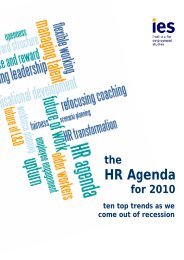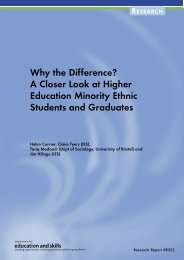- Page 1 and 2: RESEARCH Post-16 Transitions: a Lon
- Page 3 and 4: Acknowledgements The authors would
- Page 5 and 6: Contents Executive Summary viii 1.
- Page 7 and 8: Executive Summary Introduction This
- Page 9 and 10: help or information from the young
- Page 11 and 12: profound difficulties and those whi
- Page 14 and 15: 1. Introduction This report present
- Page 16 and 17: Main-stage fieldwork The aim in the
- Page 18 and 19: Table 1.2: Estimates of the number
- Page 20 and 21: • Chapter ten draws together the
- Page 22 and 23: when educational options have a str
- Page 24 and 25: of work-related training schemes. I
- Page 26 and 27: without very considerable effort on
- Page 28 and 29: introduction of a Children’s Bill
- Page 32 and 33: difficulties. The less common forms
- Page 34 and 35: Table 3.6: Statement of special edu
- Page 36 and 37: Table 3.10: Change in SEN status N
- Page 38 and 39: severe learning difficulties/profou
- Page 40 and 41: 4. School and Outcomes A primary ai
- Page 42 and 43: Table 4.2: Young person’s recall
- Page 44 and 45: Table 4.5: Reasons why transition p
- Page 46 and 47: Table 4.7: People involved in the t
- Page 48 and 49: Table 4.9: Coverage of transition p
- Page 50 and 51: Table 4.10: Coverage of transition
- Page 52 and 53: Figure 4:3: Reasons why Year 11 dis
- Page 54 and 55: Table 4.13: Provider of help to pre
- Page 56 and 57: Table 4.15: Most helpful person whe
- Page 58 and 59: Table 4.18: Extent to which school
- Page 60 and 61: In cases such as these, transition
- Page 62 and 63: were choices but young person and f
- Page 64 and 65: Figure 4:6: Young People’s views
- Page 66 and 67: “In school he had quite a lot of
- Page 68 and 69: Figure 4.7: Whether gained qualific
- Page 70 and 71: Figure 4.11: Level of qualification
- Page 72 and 73: • Over three-quarters of all youn
- Page 74 and 75: Table 5.1: Current main activity Al
- Page 76 and 77: Table 5.4: Current main activity, b
- Page 78 and 79: Table 5.6: Current main activity, b
- Page 80 and 81:
college for people with LDD, and we
- Page 82 and 83:
transition plan to have sought advi
- Page 84 and 85:
5.2.3 Ease of transition The majori
- Page 86 and 87:
Table 5.14: Occupation/training typ
- Page 88 and 89:
5.3.3 Method of jobsearch and advic
- Page 90 and 91:
• help to progress into work/trai
- Page 92 and 93:
Table 5.21: Reasons for current ina
- Page 94 and 95:
Table 5.24: Advice received when lo
- Page 96 and 97:
However, he was finding this new co
- Page 98 and 99:
years, often in quite productive ac
- Page 100 and 101:
Table 5.25: Parent/carer view on ex
- Page 102 and 103:
employment or a training placement
- Page 104 and 105:
Figure 6:2: Benefit receipt, by SEN
- Page 106 and 107:
had not had any subsequent contact
- Page 108 and 109:
Table 6.3: Type of support lost sin
- Page 110 and 111:
Table 6.5: Additional support recei
- Page 112 and 113:
met by his special school sixth for
- Page 114 and 115:
education since their child left Ye
- Page 116 and 117:
• colleges (33 per cent of parent
- Page 118 and 119:
published information against just
- Page 120 and 121:
who had a statement of SEN and/or h
- Page 122 and 123:
Table 6.12: Parent/carer knowledge
- Page 124 and 125:
Figure 7:1: Qualifications gained (
- Page 126 and 127:
Parents were also asked to reflect
- Page 128 and 129:
“(He is) a bit more independent;
- Page 130 and 131:
immaturity and the fact that she is
- Page 132 and 133:
8. Leisure Activities and Social Li
- Page 134 and 135:
Figure 8:2: Weekday evenings spent
- Page 136 and 137:
For some young people, the involvem
- Page 138 and 139:
For Li, who has found his own way o
- Page 140 and 141:
Figure 9:2: Parental views on young
- Page 142 and 143:
Table 9.1: Views on the future, all
- Page 144 and 145:
Table 9.5: View (4) on the future,
- Page 146 and 147:
9.3 Next activity Almost three-quar
- Page 148 and 149:
plans for their futures but for var
- Page 150 and 151:
10. Conclusions 10.1 Introduction T
- Page 152 and 153:
Transition planning is purposely fo
- Page 154 and 155:
needs in both the academic and the
- Page 156 and 157:
and most reported that they had mor
- Page 158 and 159:
the most severe and complex difficu
- Page 160 and 161:
Appendix One: Wave 2 survey Summary
- Page 162 and 163:
Table A.1: Profile of participating
- Page 164 and 165:
10.5.2 Weighting Table A.3 reports
- Page 166 and 167:
• Economic factors • Structural
- Page 168 and 169:
gave their consent and who lived in
- Page 170 and 171:
Gareth is a young man with learning
- Page 172 and 173:
she does not succeed, her Connexion
- Page 174 and 175:
examples here are Maria who wants t
- Page 176 and 177:
time to themselves. The problem for
- Page 178 and 179:
here. He is one of the nicest peopl
- Page 180 and 181:
Appendix Four: References Bignall T
- Page 182:
Copies of this publication can be o

















